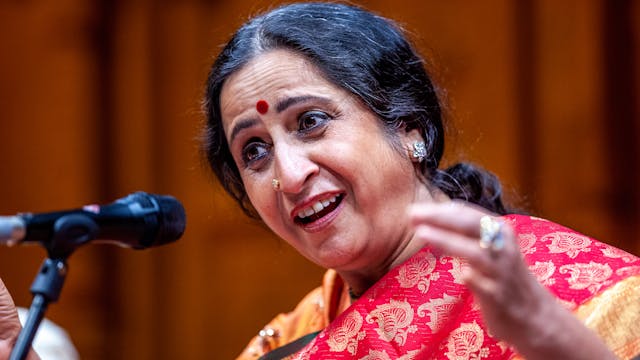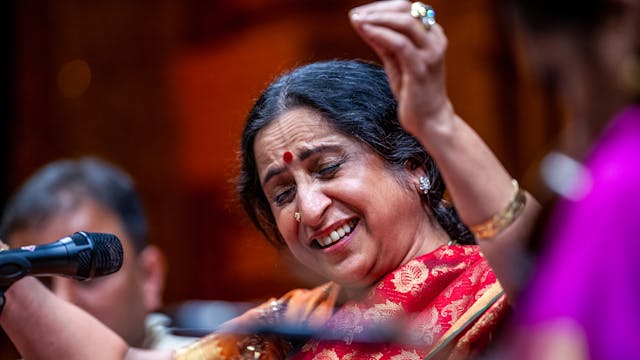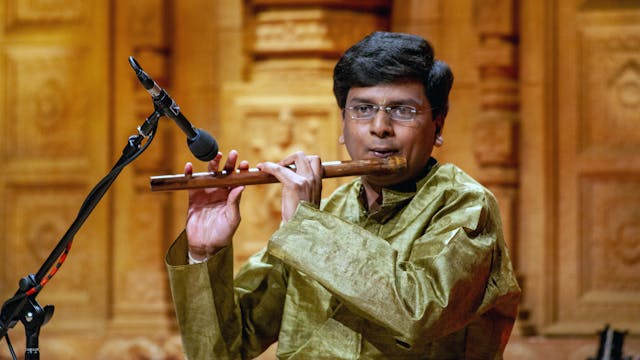Jyotsna Srikanth | Mohanam
Carnatic Tradition
•
3m 53s
Recorded at Darbar Festival 2007, on 15th April, at the Phoenix Theatre Leicester.
Musicians:
- Jyotsna Srikanth (violin)
- Neyveli Venkatesh (mridangam)
- RN Prakash (ghatam and khanjira)
Varnam in Raag Mohanam in Adi talam
This is the opening piece of Dr. Jyotsna Srikanth’s concert at the Darbar Festival 2007. This year saw a uniqueness in Darbar’s efforts in curation. Artists from the UK were combined and presented with artists from India. In this concert, Dr. Shrikanth, who was based in the UK then, led the ensemble as the soloist. She was paired with Neyveli Venkatesh from India on the mridangam. Performing a commendable dual role was RN Prakash on the ghatam and khanjira.
Dr. Srikanth starts her concert with a varnam in Raag Mohanam set to Adi talam. She calls this piece a ‘warm-up’ for the recital. Establishing the essence of Mohanam within a single phrase, Dr. Srikanth swiftly gives a crisp delivery of the composition in the characteristic warm tone of her violin.
Known for his superb capacity to align rhythmic accompaniment to melody, Venkatesh gives a brilliant and energetic opening to this piece on the mridangam. Prakash’s ghatam is tuned in, making the song vibrant and a befitting welcome for the rest of the recital.
Venkatesh was born in a remote and non-descript, industrial town in southern India called Neyveli. But it was music that brought him out of its confines and made him a globe-trotting performer in all the five continents. He has learned mridangam from his father, A.S. Balaraman and then took advanced training from Ramanathapuram M.N. Kandaswamy and has gone on to become one of the finest mridangam players of India.
Prakash blends in wonderfully with the ensemble with a pleasing accompaniment on the ghatam. Born and trained in India, Prakash is one of the leading UK-based Carnatic percussionists who also holds an important position as faculty in the London School of Carnatic Music.
Mohanam is an upangaa janya of the 28th meḷakarta Harikambhoji. It is an auḍava raga. The swaras present are ṣaḍja, chatusruti riṣabha, antara gandhara, panchama, chatusruti dhaivata. Its arohaṇa and avarohaṇa are
S R2 G3 P D2 Ṡ - Ṡ D2 P G3 R2 S.
Mohanam is an ancient raga, earlier known as Regupti. It corresponds to Raag Bhup or Bhoopali of Hindustani music. This scale is found in the music of many countries. It is a rakti raga (a raga which pleases instantaneously) and a major raga that offers ample scope for improvisation. It depicts universal peace and can be found in many South East Asian Music traditions.
Riṣabha, gandhara and dhaivata are ragachaya swaras. All the swaras are nyasa swaras. R-D, R-P, G-D are vadi-samvadi swaras (consonant notes).
It can portray rasas like karuṇa (compassion), sriṅgaraaa (romantic), adbhuta (wonder), śanta (tranquil), vira (valour) very effectively, just as it can convey the feeling of devotion or bhakti bhava.
Up Next in Carnatic Tradition
-
Aruna Sairam | Mohanam
Recorded at Darbar Festival 2009, on 3rd April, at the Purcell Room of London's Southbank Centre.
Musicians:
- Aruna Sairam (Carnatic Vocal)
- Patri Satish Kumar (Mridangam)
- Jyotsna Srikanth (Violin)
- RN Prakash (Ghatam)
- Priya Prakash (Tanpura)Kriti in Raga Mohanam in Adi talam
Raga ...
-
Aruna Sairam | Kalinga Nartana Tillana
Recorded at Darbar Festival 2009, on 3rd April, at the Purcell Room, at the Queen Elizabeth Hall, at London's Southbank Centre.
Musicians:
- Aruna Sairam (vocals)
- Jyotsna Srikanth (violin)
- Patri Satish Kumar (mridangam)
- RN Prakash (ghatam)
- Priya Parkash (tanpura)Thillana in R...
-
Mysore A Chandan | Vijayshri
Recorded at Darbar Festival 2007 on 14th April at the Phoenix Theatre, Leicester.
Musicians:
- Mysore A Chandan (flute)
- Dr. Jyotsna Srikanth (violin)
- Neyveli Venkatesh (mridangam)
- RN Prakash (ghatam)
Raag Vijaysri, instrumental composition by Saint Thyagaraja (1767-1847)‘Varanarad...



